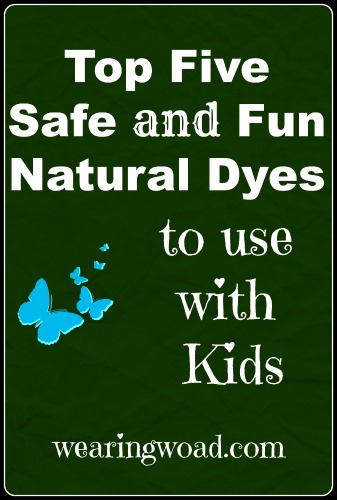Some of the most enjoyable times I have spent with natural dyes, was when I was teaching adults and families how to successfully use natural dyes. Many families have children of varying ages, and it can be a challenge to decide what natural dyes are safest, and most enjoyable, for all present.
For myself, I started assisting with natural dye vats when I was around 8 years old. And, by the time I was 13, I was able to create and use an Indigo dye vat with only adult supervision, not help. While most natural dyes are 100% safe, the following are five of my personal easy and fun favorites that are also safe.
Indigo and Woad:
Indigo is the most magical of natural dyes, and provided you use Soda Ash to change the pH, it is perfectly safe and fun for all age groups. Children and adults alike can be fascinated by the “magic” color change of the indigo vat, and while adults enjoy the science behind it, the kids find it pure fun. 
For working with a normal indigo vat, a simple shibori resist dye technique is usually most effective. Basic resists, such as buttons and elastics, can be applied to fabric by even the youngest children. And after dyeing, everyone is always excited to see what “their” project looks like.
Woad is the same as indigo, for the blue part. However, woad has the added benefit of providing yellows, and other tones from its leaves. One fascinating project would be to see how many colors one could achieve from just the woad plant, and then see how you could use those colors together in a project.
Walnut:
This is a beautiful brown dye, and is as fun to harvest as it is to dye with. Kids can help collect the walnut hulls (gloves are preferred), and can also help break the hulls off the nuts and set them aside for dye. Walnut is one of the few non-indigo dyes that does not need a mordant to be fast. However, if you are dyeing fabric, you can wind it around a piece of iron when wet, which will cause the color to change to black where the iron touches the fabric. This can be a good way to demonstrate to children how metal mordants can impact the color of the dye.
Walnut dye can also be used for ink, such as would be used in a fountain pen or a feather pen. Which is equally fun to use, and older kids can learn a bit of calligraphy with the ink they helped make. Adding a touch of iron to the ink will turn it from a dark brown to a black.
Goldenrod and Onion skins:
These are two of the easiest local yellows for me, but you can use other wild and plentiful yellows as well. The benefit of goldenrod is that the children can help harvest and prepare the dye. Goldenrod is an excellent candidate for direct contact dyeing, due to the large and detailed flower heads. While onion skins are not a fully colorfast natural dye, they can be used on smaller projects such as dyeing Easter eggs, with good success.
Tannins: Tea or coffee
If you have a dull or stained white shirt, few things are as easy to use to perk it up as a quick run through a tannin dye vat. Tannins are also used as an extra mordant on cotton, along with alum, and tea and coffee are both relatively fast natural dyes (as anyone knows who has spilled coffee on a special white shirt…). Being found in nearly every kitchen, you can use your tea bags and coffee grounds, after brewing your drink, either together or separately. As both are edible and readily available, they are prime candidates to use with children, or with anyone who is looking for an introduction to natural dyes.
Food Scraps: Avocado and Pomegranate skins
Food scraps, like the earlier mentioned onion skins, and tea and coffee, can provide a wealth of natural dyes. Other, less likely to be noticed, food scrap natural dyes are Avacado skins and pits, and Pomegranate skins. Avocado skins and smashed up pits will make a pinkish color that is light and wash-fast. Pomegranate skins give a very strong yellow, or a black when combined with a bit of iron.
However, some food scraps may not give as fast natural dyes as one could wish. Be aware of the five top fugitive natural dyes, to make sure you don’t use a fugitive dye on a project that needs to remain colorfast. If you need more information on colorfast natural dyes, you can check out the top seven not so fugitive natural dyes as well.
I had a situation where I used some dusty leaves in a Direct Contact Dyeing experiment, as well as pomegranate skins. When I unwrapped my fabric, I found that the dust had contained iron as it had changed the pomegranate yellow to black wherever the dust and dye had come in contact.
Back To You:
What natural dyes have you used with mixed groups or with kids? What dyes would you recommend to use with kids, or with people who are new to natural dyeing?
Leave a comment! I love hearing from you.